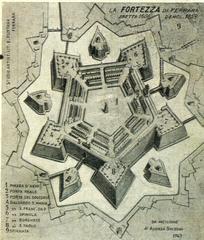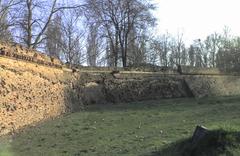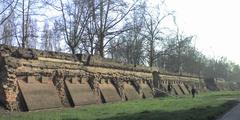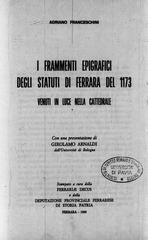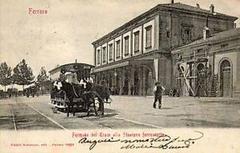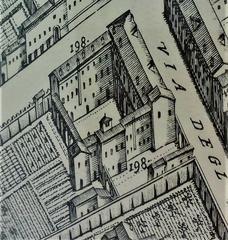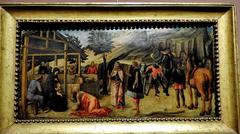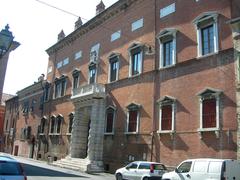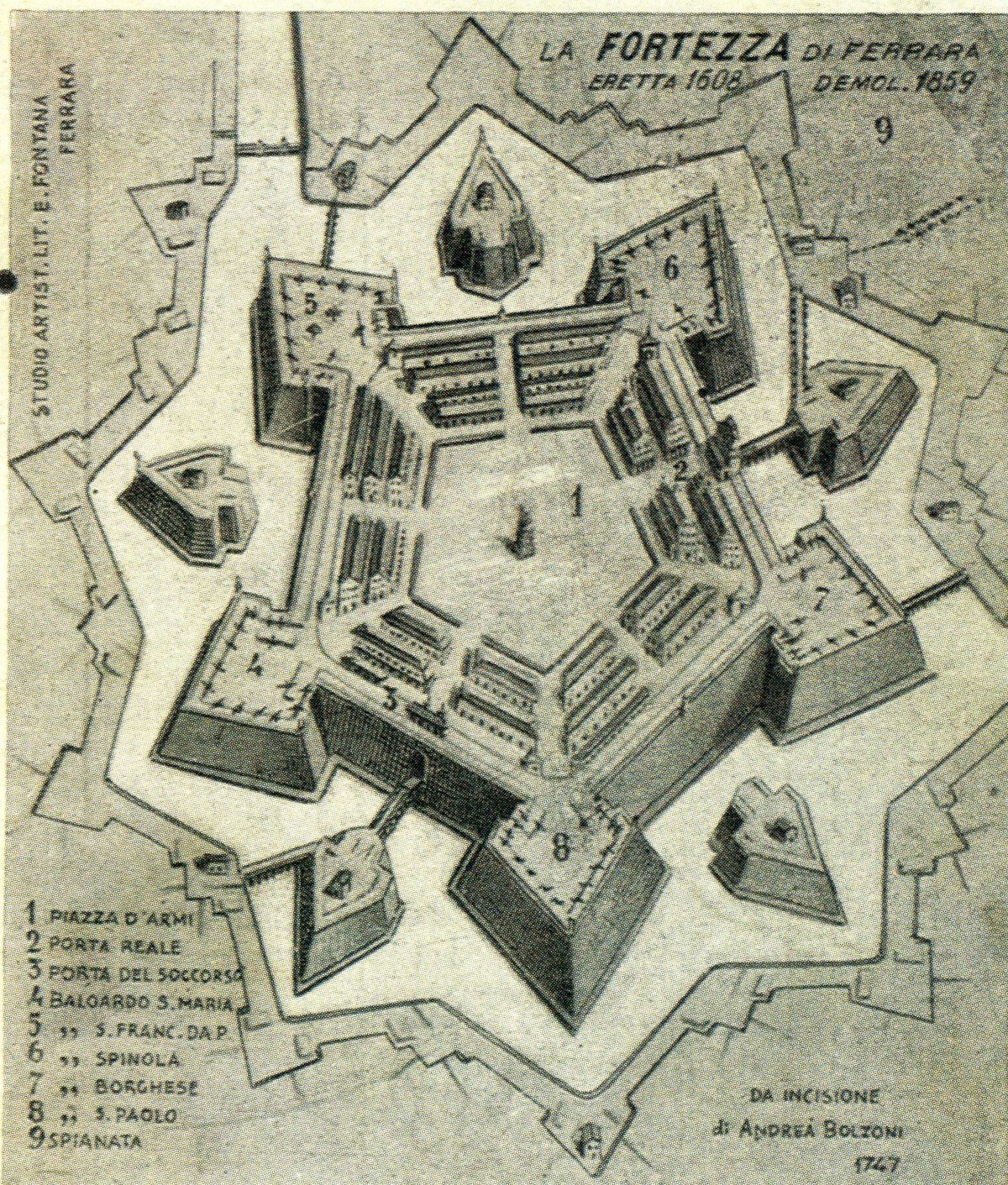
Walls of Ferrara Visiting Hours, Tickets, and Historical Sites Guide
Date: 15/06/2025
Introduction
The Walls of Ferrara are a remarkable testament to the city’s layered history and cultural richness. Stretching nearly nine kilometers around the historic center, these fortifications represent one of Italy’s most complete and architecturally significant defensive systems. Their development—from medieval earthworks to Renaissance bastions—mirrors advances in military technology and the Este family’s vision of Ferrara as a model Renaissance city (Museo Ferrara; Italy Magazine; Inferrara).
Today, the walls serve not only as a historical monument but also as a vibrant urban park, open to visitors year-round for walking, cycling, and cultural events. Their accessibility, historical narratives, scenic pathways, and proximity to landmarks like Este Castle and the Cathedral of San Giorgio make the Walls of Ferrara essential for any visitor to the city (Ferrara Terra e Acqua; travelemiliaromagna.it).
This guide covers the walls’ historical evolution, architectural highlights, visiting hours, ticketing, accessibility, travel tips, nearby attractions, and practical visitor information.
Table of Contents
- Origins and Early Development
- Renaissance Transformation: The Addizione Erculea
- Papal Modifications and Further Expansion
- Key Architectural Features
- Visiting Hours, Tickets, and Accessibility
- Travel Tips and Nearby Attractions
- Cultural Significance and Urban Role
- Restoration and Modern Use
- Frequently Asked Questions (FAQ)
- Practical Visitor Information
- Summary and Call to Action
- References
Origins and Early Development
The earliest city walls of Ferrara date to the Middle Ages, when the settlement emerged along the Po River. Initial defenses consisted of earthworks and wooden palisades, gradually replaced by brick and stone as the city grew under Este rule (Museo Ferrara). Significant expansion began in the late 14th century under Niccolò II d’Este, who extended the perimeter northward with new, vertical walls suited to resisting medieval siege tactics (Italy Magazine).
Renaissance Transformation: The Addizione Erculea
A pivotal transformation occurred at the end of the 15th century, when Duke Ercole I d’Este launched the “Addizione Erculea,” a groundbreaking urban expansion designed by Biagio Rossetti (Inferrara). This project doubled the city’s size, introduced geometric planning, and saw the construction of lower, thicker ramparts with bastions and wide moats—innovations that responded to the advent of artillery (Ferrara Terra e Acqua). The Addizione Erculea remains a milestone in the history of Renaissance urban planning (ferrarainfo.com).
Papal Modifications and Further Expansion
In the early 16th century, Alfonso I d’Este commissioned the eastern walls, further reinforcing Ferrara’s defenses with bastions and imposing gates. After Ferrara’s annexation by the Papal States in 1598, monumental structures like Porta Paola were added, and a pentagonal fortress (now lost) was built at the southwestern tip (Inferrara). These modifications affirmed Ferrara’s strategic importance and enhanced the city’s architectural grandeur.
Key Architectural Features
The Walls of Ferrara are notable for:
- Curtain Walls: Massive brick ramparts with crenellations.
- Bastions: Angular projections allowing defenders to cover adjacent sections with crossfire.
- Towers: Such as Torrione del Barco and Torrione di San Giovanni, blending medieval and Renaissance styles.
- Gates: Monumental entrances including Porta Paola and Porta degli Angeli, both defensive and ceremonial.
- Moats: Wide, shallow ditches that once impeded attackers.
This integrated system demonstrates the evolution of military architecture from medieval to Renaissance forms, adapted to withstand both siege engines and cannon fire (PlanetWare; ferraraterraeacqua.it).
Visiting Hours, Tickets, and Accessibility
- General Access: The walls and adjacent parks are open daily, year-round, from dawn to dusk. Most of the perimeter is freely accessible as a public park.
- Tickets: No ticket is required for walking or cycling the walls. Guided tours, entry to certain towers, or museum facilities may require tickets, generally priced €10–€20 (Italy Heaven).
- Accessibility: Most paths are flat, shaded, and suitable for all ages and abilities. Some historic segments have uneven surfaces; consult local information for the most accessible routes.
- Guided Tours: Local operators and the Tourist Information Office offer guided walking and cycling tours, some enhanced with augmented reality through the “Mura Aperte” project (travelemiliaromagna.it).
Travel Tips and Nearby Attractions
- Best Times: Visit in spring or autumn for mild weather and lush greenery. Early mornings and late afternoons offer the best light for photography.
- Route Suggestions: Begin at Porta degli Angeli or Castello Estense and follow the circuit clockwise, stopping at bastions and scenic viewpoints.
- Nearby Sights: Easily combine your visit with Este Castle, Ferrara Cathedral, Palazzo dei Diamanti, and the Jewish Quarter (thetouristchecklist.com).
- Food: Cafés and trattorias near the walls serve specialties like cappellacci di zucca and coppia ferrarese bread (ferrara-store.it).
Cultural Significance and Urban Role
The walls are a symbol of Este power and Ferrara’s civic identity, framing the city both physically and culturally (Museo Ferrara). Designated as a UNESCO World Heritage Site in 1995, Ferrara’s walls are recognized for their contribution to Renaissance urbanism (Italy Magazine; ferrarainfo.com). Over time, the walls have shifted from a military function to becoming Ferrara’s most cherished public park, hosting festivals and inspiring artists and writers.
Restoration and Modern Use
Restoration efforts since the late 20th century have preserved the walls’ integrity, stabilized brickwork, and improved public access (Ferrara Terra e Acqua). The “Mura Aperte” project brings history to life through augmented reality, while the walls’ green spaces offer a tranquil escape for residents and visitors alike.
Frequently Asked Questions (FAQ)
Q: Is there an entry fee to walk along the walls?
A: No, general access is free. Some museums or guided tours may require tickets.
Q: What are the walls’ opening hours?
A: Public areas are open daily from dawn to dusk. Check official sites for special openings.
Q: Are the walls accessible to people with mobility issues?
A: Most paths are accessible; some sections may be uneven.
Q: Can I cycle the walls?
A: Yes, cycling is popular, and rentals are available in the city center.
Q: Are guided tours available?
A: Yes, bookable through the Tourist Information Office or local providers.
Q: Are dogs allowed?
A: Yes, but they must be leashed.
Practical Visitor Information
Getting There
- By Train: Ferrara is on the main Venice–Bologna line. The station is 1.6 km from the walls (Italy Heaven).
- By Bus: Local buses (lines 4 and 11) connect the station to city center and wall access points (Italyscapes).
- By Car: Park in lots outside the walls; much of the center is pedestrianized.
Facilities
- Tourist Information: Located at Castello Estense (Main Tourist Information Office).
- Restrooms: Available near main gates and parks.
- Refreshments: Numerous cafés and food stalls near central squares, especially during festivals.
Summary and Call to Action
The Walls of Ferrara offer a unique opportunity to journey through centuries of history, urban innovation, and culture. Free public access, scenic pathways, and integration with Ferrara’s main attractions make the walls a highlight of any visit. For a richer experience, take advantage of guided tours (including augmented reality) and seasonal events.
Stay connected for updates by downloading the Audiala app, which provides interactive maps, audio guides, and event notifications. Follow our social media channels for the latest on Ferrara’s vibrant cultural scene.
Begin your Renaissance adventure—explore the Walls of Ferrara today!
